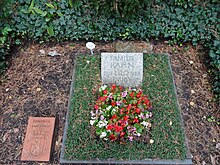Erich Rahn
Erich Rahn (born May 1, 1885 in Berlin ; † July 5, 1973 in Berlin) was a pioneer of Jiu-Jitsu and judo sports in Germany. In 1906 he founded the first German Jiu-Jitsu school in Berlin with the Rahn sports school. He is also the founder of the German Jiu-Jitsu-Ring Erich Rahn eV
Live and act
The history of Jiu Jitsu in Germany is closely linked to the name Erich Rahns. Rahn came into contact with Japanese people from an early age through his father's commercial relationships . During these encounters, he got to know various budo techniques. At the same time, the first Japanese athletes were giving shows in European variety theaters, in which they presented judo and jiu-jitsu techniques. At one of these performances, the young Erich Rahn got to know Katsuguma Higashi , who defeated a physically clearly superior man with the help of Jiu Jitsu. The enthusiastic Rahn became a student of Higashi and learned the techniques of Jiu Jitsu from him. Convinced of this goal, he gave up his job in order to be able to devote himself entirely to studying Jiu Jitsu.
In 1906, at the age of 21, Rahn opened the first German Jiu-Jitsu school. To make martial arts popular, Rahn gave speeches and lectures across the country. However, the public's interest in the "scuffle" was initially very low. After these failures, Rahn began to emphasize the function of Jiu Jitsu as a means of self-defense. Through this "westernization" wrestling grips, boxing hits and the use of force found their way into Jiu Jitsu.
In 1910 Erich Rahn was able to interest the Berlin criminal police for Jiu Jitsu for the first time . The then head of the criminal police asked the police chief, Traugott von Jagow , for this, and he received an invitation to a demonstration at the royal police headquarters. As a result, he was assigned the training of the criminal police and later the protective police in self-defense. In 1913, Rahn received a teaching position for Jiu Jitsu at the military gymnasium in Berlin.
After the First World War in 1919, Rahn made another attempt to popularize Jiu Jitsu outside of Berlin. He went on a variety tour through the whole of Germany and accepted every challenge in his performances, even from well-known wrestlers and boxers. He was more successful in this undertaking; soon the first clubs were opened in other cities, and Jiu Jitsu developed into a competitive sport throughout Germany. In 1920 Rahn founded the “First Berlin Jiu-Jitsu Club” in Berlin, and two years later the “Central Association of German Jiu-Jitsu Fighters”. In the same year, 1922, the first German Jiu-Jitsu championship took place in the Berlin Sports Palace . In the final, Erich Rahn defeated Hans Reuter from Munich. At the age of 40, he withdrew undefeated from public competitions.
He is buried in the forest cemetery in Zehlendorf . His grave is dedicated to the city of Berlin as an honorary grave .
literature
- Thorsten Preiß: Erich Rahn. Pioneer of Jiu-Jitsu in Germany . 1st edition. Verlag Günter Beining Foundation, Berlin 2012, ISBN 978-3-00-038403-5 ( description ).
bibliography
- The invisible weapon (Jiu-Jitsu) , 1926 Berlin, Verlag Guido Hackebeil AG
- New handles and tricks in Jiu-Jitsu / Judo, unarmed self-defense , Falken-Verlag, 1955
- I am learning Jiu-Jitsu , Torch Verlag, 1957
Filmography
- 1918: midnight
- 1921: Jiu-Jitsu - the invisible weapon
See also
Web links
- Homepage of the Rahn Sports School
- Erich Rahn in the Internet Movie Database (English)
- Short biography
| personal data | |
|---|---|
| SURNAME | Rahn, Erich |
| BRIEF DESCRIPTION | Pioneer of Jiu Jitsu and Judo sports in Germany |
| DATE OF BIRTH | May 1, 1885 |
| PLACE OF BIRTH | Berlin |
| DATE OF DEATH | 5th July 1973 |
| Place of death | Berlin |


